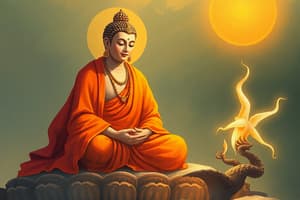Podcast
Questions and Answers
Match the following with their beliefs or teachings:
Match the following with their beliefs or teachings:
Buddhism = Pursuit of spiritual liberation Jainism = Teachings on self-control and meditation
Match the following with their historical background:
Match the following with their historical background:
Siddhartha Gautama = Founder of Buddhism Lumbini, Nepal = Birthplace of Siddhartha Gautama Kapilvastu = Royal family of the Shakyas Northern India = Location where Gautama began teaching
Match the following with their geographical significance:
Match the following with their geographical significance:
Lumbini, Nepal = Birthplace of Siddhartha Gautama Kapilvastu = Royal family of the Shakyas Northern India = Location where Gautama began teaching India Subcontinent = Origin of Buddhism and Jainism
Match the following with their focus or goal:
Match the following with their focus or goal:
Match the following with their emphasized lifestyle principles:
Match the following with their emphasized lifestyle principles:
Match the following with their teachings on detachment and enlightenment:
Match the following with their teachings on detachment and enlightenment:
Match the following with their respective religions:
Match the following with their respective religions:
Match the following with their teachings/practices:
Match the following with their teachings/practices:
Match the following with their principles/teachings:
Match the following with their principles/teachings:
Match the following with their respective figures/leaders:
Match the following with their respective figures/leaders:
Match the following with their practices/teachings:
Match the following with their practices/teachings:
Flashcards are hidden until you start studying
Study Notes
History of Buddhism and Jainism
Buddhism and Jainism are two of the oldest religions in the world, originating in the Indian subcontinent. Both religions share some similarities, such as their focus on the pursuit of spiritual liberation and their emphasis on nonviolence and compassion. However, they also have distinct differences in their beliefs, practices, and historical development.
Life of Siddhartha Gautama (Buddhism)
Siddhartha Gautama, also known as Gautama Buddha, was the founder of Buddhism. He was born in Lumbini, Nepal, in 563 BC, and was raised in the royal family of the Shakyas in Kapilvastu. At the age of 29, Gautama left his palace and his wife and child to seek enlightenment, and he achieved this goal at the age of 35. Gautama then began teaching throughout northern India what he had learned during his spiritual journey.
Gautama's teachings focused on the Four Noble Truths and the Eightfold Path, which were meant to lead individuals to the end of suffering. His teachings emphasized the pursuit of wisdom, self-control, and compassion, and he encouraged his followers to live simple lives, free from worldly attachment. Gautama's teachings also emphasized the importance of meditation, and he spent much of his life in seclusion, meditating and teaching others how to do the same.
Four Noble Truths in Buddhism
The Four Noble Truths are the core of Buddhist teachings and are considered the foundation of the Buddhist path. These truths were discovered by Gautama Buddha during his enlightenment and are as follows:
- The truth of suffering: Suffering exists and it is a constant part of life.
- The truth of the cause of suffering: Suffering is caused by craving and attachment.
- The truth of the end of suffering: Suffering can be ended through the complete elimination of craving and attachment.
- The truth of the path to the end of suffering: The Eightfold Path, a set of guidelines for ethical, mental, and spiritual development, leads to the end of suffering.
Teachings and Practices of Buddhism
Buddhist teachings and practices are centered around the pursuit of enlightenment and the elimination of suffering. This is achieved through the practice of the Eightfold Path, which includes right understanding, right intention, right speech, right action, right livelihood, right effort, right mindfulness, and right concentration.
Meditation is another central practice in Buddhism, as it helps individuals develop concentration, self-awareness, and wisdom. Many Buddhists also practice charitable acts, such as giving to the poor or volunteering at a local homeless shelter, as a way of helping others and earning merit.
Life of Mahavira in Jainism
Mahavira, also known as Vardhamana, was the founder of Jainism. He was born in 599 BC in what is now Bihar, India, to a wealthy family. At the age of 30, Mahavira renounced his worldly possessions and began his spiritual journey, which lasted for 12 years. During this time, he achieved spiritual liberation and became known as a Jina, or conqueror of the self.
Mahavira's teachings focused on the principles of nonviolence, compassion, and self-control. He emphasized the importance of living a simple life, free from attachment to worldly possessions, and practicing nonviolence towards all living beings.
Principles and Practices of Jainism
Jainism is centered around the principles of nonviolence, compassion, and self-control. Jains believe in the concept of karma, which states that every action has a consequence, and that individuals must strive to minimize their negative actions in order to achieve spiritual liberation.
Jainism also emphasizes the importance of meditation, as it helps individuals develop concentration, self-awareness, and wisdom. Jains also practice nonviolence towards all living beings, including animals, and often follow a strict vegetarian diet.
In conclusion, Buddhism and Jainism are two of the oldest religions in the world, with distinct beliefs, practices, and historical developments. Both religions focus on the pursuit of spiritual liberation and the elimination of suffering, but they approach this goal through different means and with different teachings.
Studying That Suits You
Use AI to generate personalized quizzes and flashcards to suit your learning preferences.




